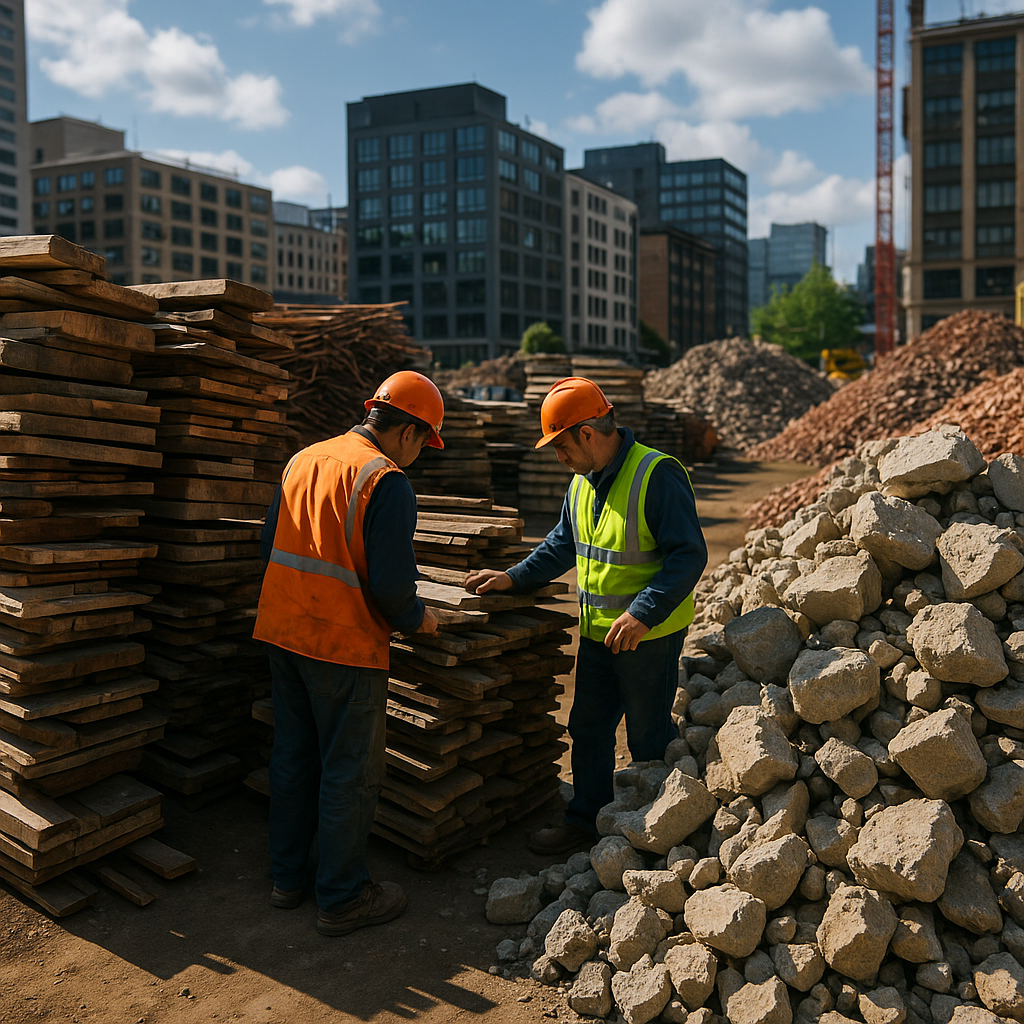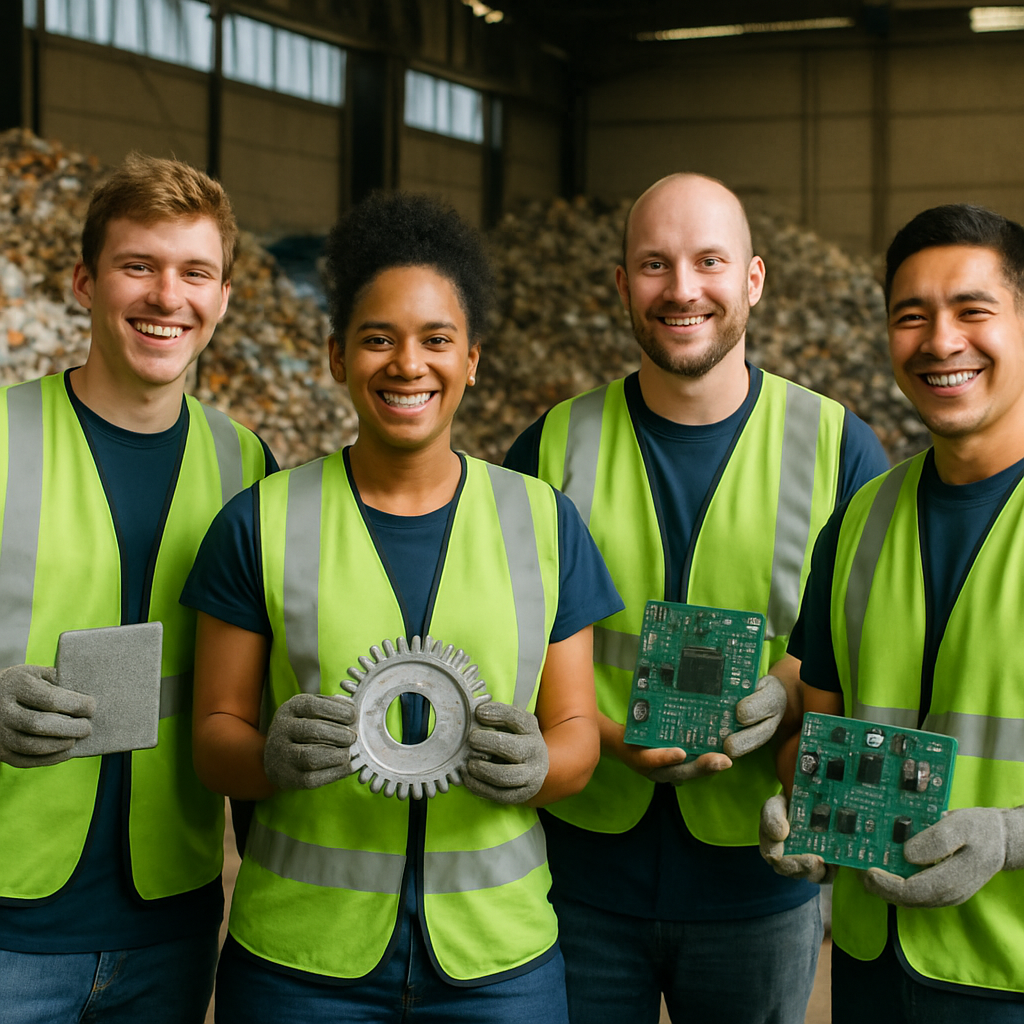5901 Botham Jean Blvd, Dallas, TX 75215
Urban Mining: How Cities Become the New Resource Mines
September 11, 2025Urban mining represents an innovative approach to resource management in our increasingly waste-generating world. Rather than extracting raw materials from the earth, urban mining reclaims valuable resources from the products we discard daily. This practice views our cities as rich deposits of reusable materials waiting to be harvested.
At its core, urban mining recovers raw materials from waste products like discarded electronics, construction debris, and demolition waste. Instead of relying on geological deposits, it taps into anthropogenic stocks—materials already processed and present in our urban environments. The concept shifts our perspective from seeing waste as a problem to recognizing it as a valuable resource.
Urban mining plays a crucial role in building a circular economy. By extracting metals like gold, copper, and aluminum from e-waste, and reclaiming concrete, bricks, and steel from construction waste, it reintegrates these materials back into production cycles. This process reduces our dependence on virgin resource extraction, minimizes landfill volumes, and extends the lifespan of finite resources that would otherwise be buried or incinerated.
How Does the Urban Mining Process Work?

Urban mining transforms waste into valuable resources through the systematic collection, sorting, and processing of materials from construction sites and demolished buildings, which would otherwise end up in landfills.
The urban mining process begins with targeted waste collection from these sites. Crews gather materials such as concrete, wood, metals, and glass. Unlike traditional waste collection, urban mining views these sites as resource banks filled with valuable materials ready for recovery.
Once collected, materials undergo rigorous sorting to separate different components. This crucial step determines the quality and value of the recovered resources. Modern sorting facilities use both manual and automated systems to process large volumes of mixed materials efficiently.
Advanced Sorting Technologies
The effectiveness of urban mining relies heavily on technology, with specific separation methods ensuring maximum recovery and purity of different materials:
Magnetic separation uses powerful magnets to pull ferrous metals like steel from mixed debris, effectively recovering almost all iron-containing materials in a waste stream, including rebar, nails, and steel framing components.
Non-ferrous metals such as copper, aluminum, and brass require eddy current separators. These machines create a magnetic field that repels non-magnetic metals, effectively separating them from other materials. This technology is vital for recovering valuable wiring, pipes, and fixtures from demolition waste.
Electrostatic separation recovers materials based on differences in electrical conductivity. As materials pass through an electrostatic field, they become charged and follow different paths based on their properties, which is particularly effective for separating plastics and non-conductive materials from metals.
Processing and Resource Recovery
After sorting, materials are processed into usable resources:
Concrete and masonry, which constitute the largest portion of construction waste by weight, are crushed and processed into recycled concrete aggregate. This serves as a substitute for virgin aggregates in new construction projects, road bases, or drainage applications.
Wood recovered from construction sites is processed based on its condition and treatment. Clean wood becomes mulch, engineered wood products, or biomass fuel, with care taken to handle treated wood with hazardous chemicals appropriately.
Metals undergo further refinement to meet industry standards. Steel is melted down and reformed into new products, while copper and aluminum are processed to remove impurities before recycling. The energy savings from recycling these metals are substantial compared to using virgin materials.
Glass and plastics require specialized processing to remove contaminants and prepare them for recycling. Though they represent a smaller percentage of construction waste, proper recovery significantly reduces their environmental impact.
On-Site Processing Innovation
A growing trend in urban mining is the use of mobile processing equipment directly at construction sites. These portable systems can crush concrete, sort metals, and prepare materials for recycling without transporting bulky waste to distant facilities.
On-site processing reduces transportation emissions by up to 90% and lowers overall project costs. Construction companies using these systems report significant savings on waste disposal fees while complying with increasingly strict environmental regulations.
The ultimate goal of urban mining is to create a closed-loop system where materials move seamlessly from one construction project to another without becoming waste. This approach supports circular economy principles in construction, turning today’s buildings into tomorrow’s material sources.
By recovering valuable resources from urban waste streams, urban mining helps conserve natural resources while reducing the environmental footprint of the construction industry. As technologies advance, the efficiency and economic viability of urban mining will increase, making it a key component of sustainable construction practices.
What Are the Benefits of Urban Mining?

Urban mining offers a strong alternative to traditional resource extraction methods, providing notable environmental and economic benefits. By reclaiming valuable materials from waste streams, this approach tackles significant sustainability challenges while creating new economic opportunities.
From an environmental standpoint, urban mining effectively reduces greenhouse gas emissions. Traditional mining is energy-intensive and often leads to deforestation, habitat destruction, and significant carbon emissions due to its reliance on fossil fuels. The mining industry is known for its extensive carbon footprint and high water consumption, which can be problematic in water-scarce regions. Urban mining circumvents these issues by utilizing existing materials, reducing the need for virgin resources.
The economic benefits of urban mining are equally significant. Businesses can achieve substantial cost savings on raw materials and reduce waste disposal expenses. Instead of incurring costs to send demolition waste to landfills, companies can repurpose these materials more economically. A recent study found recycling aluminum from end-of-life vehicles to be more cost-effective than extracting it through traditional mining techniques. Similarly, recovering copper and gold from e-waste has been shown to be as economical as traditional mining.
Urban mining supports the circular economy by keeping materials in use longer. Unlike a linear economy, which focuses on manufacturing raw materials into products for eventual disposal, the circular approach reintegrates products back into the economy. This extends the lifespan of finite resources and ensures materials are continuously recycled rather than wasted.
One strategic advantage of urban mining is recovering rare earth elements essential for modern technologies. Current demand exceeds supply by about 3,000 tons annually, with projections reaching 315,000 tons by 2030, partially due to clean energy technologies. Urban mining offers a solution to increase these critical materials’ supply, alleviating pressure on traditional supply chains.
Urban mining also reduces reliance on conflict minerals, which come from regions where control over mining operations fuels conflict. In the Democratic Republic of Congo, for instance, mineral extraction finances conflicts over materials like tin, tantalum, tungsten, and gold. Urban mining decreases the demand for newly mined resources from these areas, potentially reducing conflict and strengthening supply chain resilience.
Beyond environmental and economic gains, urban mining generates new job opportunities in waste collection, sorting, material processing, and technology development. These roles can rejuvenate industrial areas and offer employment in economically challenged communities.
| Metric | Urban Mining from E-Waste (2025 Est.) | Traditional Mining (2025 Est.) |
| Resource Recovered (tons) | 18,000,000 | 32,000,000 |
| CO₂ Emissions Saved (tons) | 25,000,000 | 0 (Emits 60,000,000) |
| Energy Consumption (GWh) | 85,000 | 400,000 |
| Estimated Recycling Rate (%) | 47% | — |
| Electronic Waste Processed (tons) | 75,000,000 | — |
As resource scarcity becomes a more urgent global issue, the advantages of urban mining will likely gain greater prominence. By turning what was once viewed as waste into valuable resources, urban mining provides a sustainable way to meet material needs while protecting the environment and supporting economic growth.
What Challenges Does Urban Mining Face?

Urban mining offers a sustainable approach to resource management, but several significant challenges hinder its broader adoption. Material separation is among the most formidable obstacles. Unlike traditional mining, where resources are found in relatively homogeneous deposits, urban waste contains a complex mix of materials, making efficient separation difficult. Concrete, glass, metals, and hazardous substances are often tightly integrated, requiring specialized equipment to isolate valuable components.
Hazardous materials pose serious safety concerns for workers in the urban mining sector. Workers often encounter dangerous substances like asbestos in construction materials or lead in electronic components, necessitating careful handling to prevent health risks. Without proper safety protocols and equipment, there is a risk of respiratory problems, neurological damage, and other serious health issues.
Financial barriers also limit the expansion of urban mining. The initial investment in specialized technology and processing equipment can be substantial. While urban mining may be financially beneficial in the long term, many organizations struggle with the upfront costs of establishing proper facilities. This economic challenge slows implementation, particularly in regions with limited capital resources.
In developing countries, the challenges are particularly acute. Many nations lack advanced technology and technical knowledge for effective e-waste processing. A study on urban mining in Sri Lanka found that the country lacks advanced processing facilities for proper e-waste disassembly. Even when technology is available, many households and businesses do not separate e-waste from other waste, complicating recovery efforts.
The lack of advanced technology has made the e-waste recycling industry financially unattractive in many developing regions. Recovering valuable materials without proper equipment requires significant manual labor and yields lower recovery rates. This increases costs while decreasing output, making potential businesses financially unstable.
Informal recycling practices present another significant challenge. In many regions, e-waste is processed at informal sites, including inside homes, without proper equipment or waste management techniques. These practices reduce material recovery rates and create serious environmental and health hazards. According to a World Health Organization report, nearly 12.9 million women work in the informal waste sector, potentially exposing themselves and their unborn children to toxic e-waste.
Despite these challenges, urban mining continues to gain momentum as technological advancements improve efficiency and cost-effectiveness. New techniques in sorting and processing materials are helping the industry overcome barriers and expand sustainable resource recovery practices worldwide.
| Aspect | Urban Mining | Traditional Mining |
|---|---|---|
| Primary Target | Electronic waste, construction and demolition waste | Geological deposits |
| Material Composition | Complex mixtures, requires advanced sorting | Relatively homogeneous deposits |
| Environmental Impact | Lower carbon footprint, reduced energy use and resource extraction | High carbon footprint, energy-intensive, environmental degradation |
| Resource Efficiency | High recovery rates of precious metals from e-waste | Lower efficiency compared to urban mining efficiency on electronic waste |
| Economic Viability | Potential for significant cost savings | Capital and resource intensive |
| Challenges | Material separation complexity, hazardous waste handling | Resource depletion, geopolitical tensions |
| Social Impact | Potential job opportunities in waste management and technology | Often contributes to social and environmental issues in mining regions |
Conclusion: The Future of Urban Mining
Urban mining signifies a crucial shift in resource management, addressing environmental, economic, and societal challenges all at once. By recovering valuable materials from waste, we reduce dependency on new resources while minimizing the environmental impacts associated with traditional mining. Extracting precious metals, critical minerals, and construction materials from urban areas presents a sustainable path forward in our resource-constrained world.
With technological advancements and growing awareness, urban mining is set to become a key component of the circular economy. Innovations in sorting technology, material separation, and processing methods are making resource recovery more efficient and economically feasible. Additionally, increased public and corporate recognition of waste as a resource is influencing policy changes that support these practices. For your metal recycling needs and to learn how your organization can benefit from urban mining practices, contact Okon Recycling at 214-717-4083.
